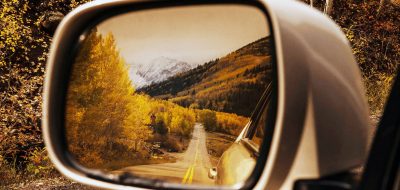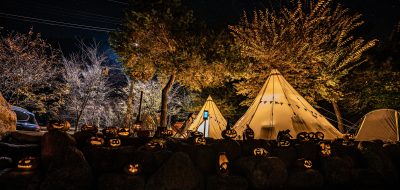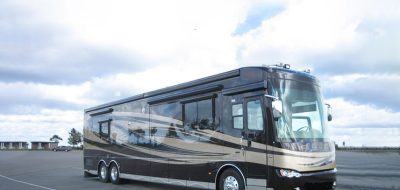Visiting national parks tops the list of reasons why many of us chose the RV lifestyle. What better way to tour these national treasures, to experience with all our senses the wondrous glacier-carved mountains, sweeping evergreen and deciduous forests, unimpeded rivers, tumbling mountain streams and waterfalls, glaciated valleys, wildflower-covered meadows, and free-roaming wildlife.

Skyline Drive, the 105-mile road that bisects the length of the park winding along the crest of the Blue Ridge Mountains, may be Shenandoah’s predominant feature, since it provides stunning views of the park’s mountains, valleys, and forests. © Rex Vogel, all rights reserved
Tennessee’s Great Smoky Mountains National Park is the most-visited park in the National Park System. The twisting, scenic mountain road that leads out of the eastern edge of Great Smoky—the 469-mile Blue Ridge Parkway—is a destination unto itself. The north end of this vista-filled parkway ends in Virginia’s Shenandoah National Park, and here RVers find plenty of nature’s bounty, teeming with beauty and outdoor adventures.
The Native Indians named the valley Shenandoah, meaning Daughter of the Stars, for the expansive firmament that roofed their world. Daylight vistas of gently sloping mountains, forests, and tumbling rivers, and mountain streams are equally sparkling.
Unlike most national parks, Shenandoah is a place where settlers lived for over a century. To create the park, the Commonwealth of Virginia acquired 1,088 privately owned tracts and donated the land to the nation.
Much of Shenandoah consisted of farmland and second- or third-growth forests logged since the early 1700s. Today the marks of lumbering, grazing, and farming have mostly disappeared, as forests have slowly grown back.
Before the park opened and during its early days, some 465 families moved or were moved from their cabins and resettled outside the proposed park boundaries. A few mountaineers lived out their lives in the park and were buried in the secluded graveyards of Shenandoah’s disappearing settlements.
Shenandoah Song
Anyone who has listened to John Denver sing about country roads and the Blue Ridge Mountains can easily imagine the transcendent beauty of Shenandoah National Park. Visitors from around the world travel the renowned and spectacular Skyline Drive, one of the great scenic byways of America.

The Native Indians named the valley Shenandoah, meaning Daughter of the Stars, for the expansive firmament that roofed their world. © Rex Vogel, all rights reserved
Hikers trek into the forest along the more than 500 miles of trails, including 101 miles of the famed Appalachian Trail and are rewarded with some of the most scenic views of Shenandoah. Horse owners saddle up and explore the 150 miles of horse trails.
Native eastern brook trout challenge anglers in the numerous nearby streams.
And many others come to escape the pressures of a fast-paced world and spend some quiet time intertwined with the best that nature has to offer.
To the east of the park, the Piedmont country’s rolling hills act as counterpoint to the park’s spine, the Blue Ridge Mountains.
To the west, the Shenandoah River finds its way through the oak-hickory forest, home to black bears and deer and nearly 50 other species of mammals, and over 200 species of birds, including wild turkeys.
Park campgrounds generally open in April and May, but RVers are advised to check on road conditions before setting out.
Shenandoah National Park offers something for everyone! From the breathtaking views along the Skyline Drive, to the splendor of watching a bear and her cubs, to the thrill of hiking to a mountain summit, it’s hard to leave Shenandoah without being inspired.
Whether you’re looking to get in touch with nature, discover a piece of history, or simply relax and renew in a serene environment, Shenandoah offers activities for visitors of all ages and interests.
Note: The clearance of Marys Rock Tunnel (just south of Thornton Gap entrance from Route 211) is 12’8”. Know you height including air conditioner and be sure you will clear.
Did You Know?
The first Civilian Conservation Corps (CCC) camp in a national park was Shenandoah National Park’s NP-1 established near Skyland in May 1933. The second National Park Service camp was also in Shenandoah National Park, camp NP-2 at Big Meadows.
Note: This is the first of a four-part series on Shenandoah National Park and its 75th anniversary celebration.
Part 2: Driving the Skyline Drive
Part 3: Away I Go to Shenandoah
Part 4: Celebrating 75 Years
Worth Pondering…
Country Roads
Almost heaven, West Virginia
Blue Ridge Mountains, Shenandoah River
Life is old there, older than the trees
Younger than the mountains, blowing like a breeze
Country roads, take me home
To the place, I be-long
West Virginia, mountain momma
Take me home, country roads.
—John Denver
You May Also Like
- Closing California Parks: Legal & Practical Issues
- 30 Tips to Cut Your RV Travel Expenses
- High Rise Apartment: Montezuma Castle National Monument, AZ
- Is Your RV Ready for the Road?
If you enjoy these articles and want to read more on RV travels and lifestyle, visit my website: Vogel Talks RVing.







Woodalls Editorial Staff
Hi Ron~
That is really interesting! We had no idea that Mr. Denver was a flat lander. Thanks for the info.
Ron King
It is ineresting to note that John Denver grew up as a flat lander inbetween the cities of Dallas and Forth Worth. The only mountain he was ever to be High about was on a water tower in the Midcities. So when he got to the Blue Ridge Mountains he was inspired to write his song Country Roads. I too lived many years in the Dallas area and was to inspired for the same reason of the vistas of the Blue Ridge Country in my Motorhome. I now live in Georgia and each year make trips to the Smokey Mountains! Ron